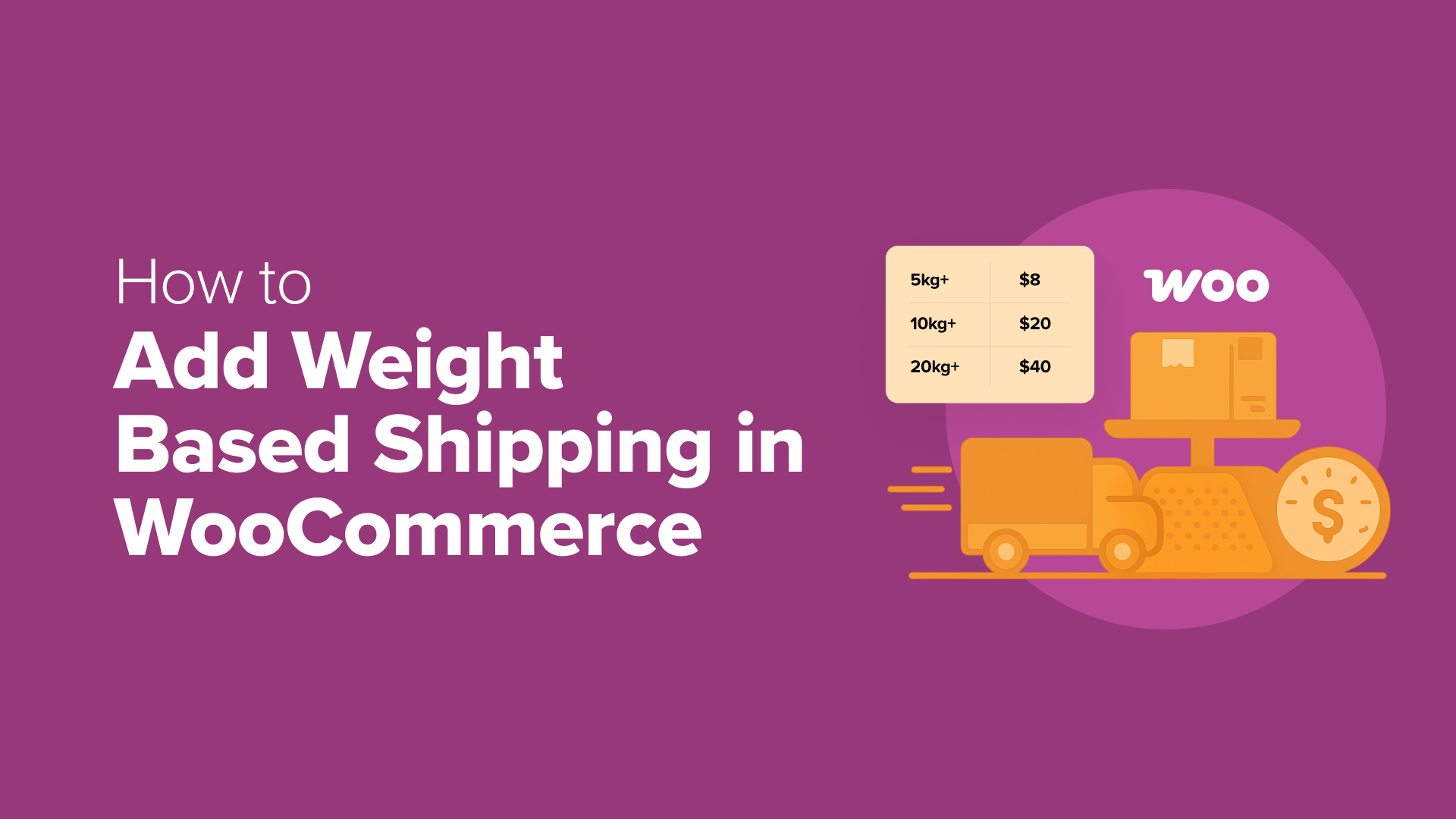Surprising transport prices are one of many greatest causes prospects abandon their carts. In case your WooCommerce retailer fees an excessive amount of or the pricing feels complicated, then you would be shedding gross sales with out realizing it.
That’s why it’s so essential to supply clear, truthful transport charges. And one of many easiest methods to do this is with weight-based transport.
With this technique, transport prices are calculated primarily based on the entire weight of the cart. Lighter orders get decrease charges, whereas heavier ones are charged extra precisely, serving to you cowl your prices with out turning prospects away.
I’ve frolicked testing each WooCommerce’s built-in instruments and third-party plugins to seek out the perfect methods to set this up.
On this information, I’ll present you precisely find out how to add weight-based transport to your retailer. Plus, I’ll share some sensible tricks to keep away from frequent pitfalls and maintain your checkout course of clean. 🚚
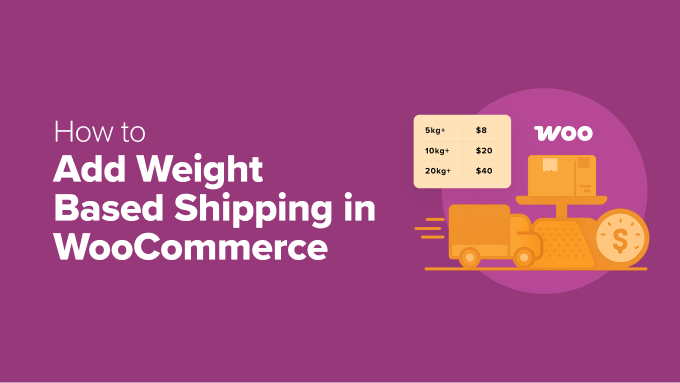

Why Provide Weight-Primarily based Delivery in WooCommerce?
Weight-based transport ensures truthful and correct supply prices by calculating charges primarily based on the precise weight of the order.
Not like flat price transport, which fees the identical payment for each buy, this technique prevents overcharging for light-weight objects and shedding cash on heavy ones.
By switching to weight-based transport in your WooCommerce retailer, you get extra management and suppleness. It removes guesswork, avoids surprises at checkout, and retains prices clear.
It’s particularly helpful for shops that promote heavy objects, bundles, or a mixture of light-weight and hulking merchandise.
Whether or not you’re transport furnishings, books, or fitness center tools, this helps you keep worthwhile whereas conserving transport prices clear in your prospects.
Having mentioned that, let’s check out find out how to simply add weight-based transport in WooCommerce. I’ll cowl two completely different strategies on this tutorial. You should use the hyperlinks under to leap to the strategy of your selection:
Methodology 1: Add Weight Primarily based Delivery Utilizing the Default Settings (Primary Settings)
If you wish to arrange weight-based transport in WooCommerce with out utilizing any additional WooCommerce plugins or extensions, then this technique is for you.
WooCommerce doesn’t include a built-in weight-based transport choice, however there’s a easy workaround you should utilize.
As an alternative of a direct weight-based setting, you should utilize transport courses to group merchandise by their weight. Then, you possibly can create completely different flat charges for every class inside your transport zones.
This manner, heavier objects can have increased transport prices, and lighter ones can ship for much less, all utilizing the default WooCommerce settings.
💡 Professional Tip: Earlier than you begin, ensure you have set your most well-liked weight unit (e.g., kg, lbs, oz) in your retailer.
You are able to do this by navigating to WooCommerce » Settings » Merchandise » Common and choosing your unit from the ‘Weight unit’ dropdown menu. This ensures all of your calculations are constant.
For extra assist configuring your retailer, observe our full information to WooCommerce retailer setup.
To get began, go to the WooCommerce » Settings » Delivery » Courses web page from the CMS dashboard and click on the ‘Add transport class’ button.
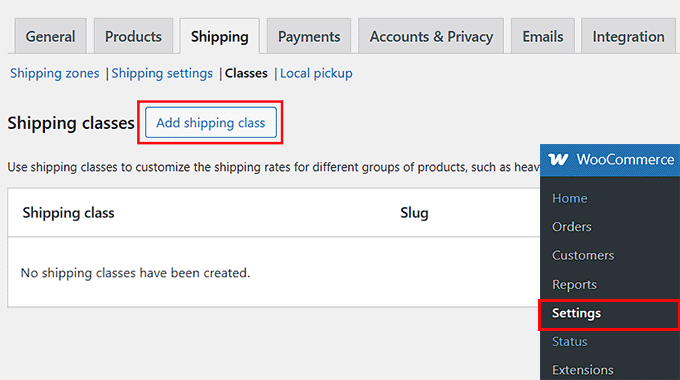

Within the pop-up that seems, add a reputation in your transport class. I like to recommend selecting one thing clear that helps you shortly acknowledge the kind of merchandise it’s for.
For instance, for those who’re creating a category for all of the objects beneath 5 kg, you then may title it ‘Underneath 5kg.’
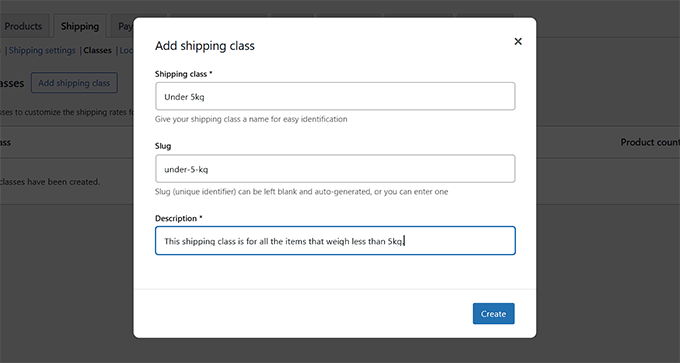

Then, you’ll want so as to add a slug for the category. You can even depart this clean, and WooCommerce will generate one primarily based on the title you enter.
However if you need extra management, you possibly can enter your personal.
Subsequent, add a brief notice explaining what the transport class is for. It’s primarily in your personal reference or for different admins engaged on the positioning.
Then, go forward and click on the ‘Create’ button.
Now you can repeat the method so as to add as many weight primarily based transport courses as you need.
As soon as you’re finished, it should look one thing like this:
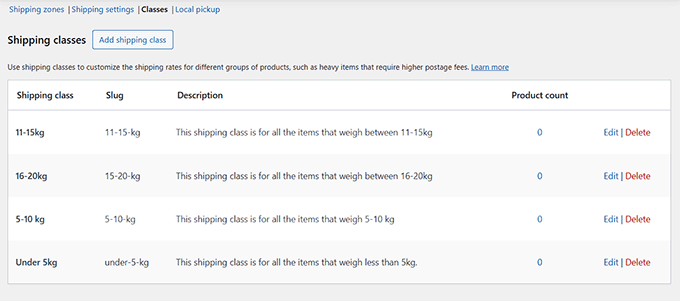

Subsequent, go to the ‘Delivery Zones’ tab. Right here, you’ll see a listing of all of the transport zones you’ve arrange in your retailer. These zones symbolize the international locations or areas the place you supply transport.
Should you haven’t added a transport zone but, merely click on the ‘Add zone’ button.


This can take you to a brand new display screen the place you possibly can add a reputation. I like to recommend naming the zone after the area or nation you’re providing transport to, as this may help forestall any confusion.
After that, merely sort the title of the area or nation within the ‘Zone areas’ discipline. When the choice seems, click on on it so as to add it to your zone. You’ll be able to add as many areas as you need.
When you’re finished, click on the ‘Add transport technique’ button to proceed.
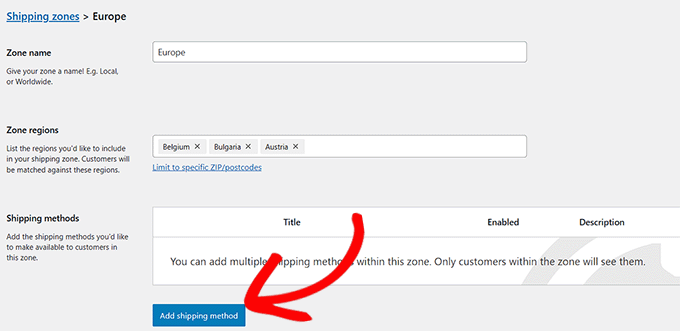

A brand new popup will now seem in your display screen.
From right here, choose the ‘Flat price’ choice and click on ‘Proceed.’


Within the subsequent step, you’ll want to offer your transport technique a reputation. That is essential as a result of your prospects will see it at checkout.
A reputation like ‘Delivery Price Primarily based on Product Weight’ is evident and descriptive.
Subsequent, add a value for transport within the ‘Price’ discipline. This would be the default transport value that prospects can pay when buying an merchandise.
That is the bottom transport value for any product with no transport class. Take into account, this value may also be added to different transport charges, which I’ll clarify in a second.
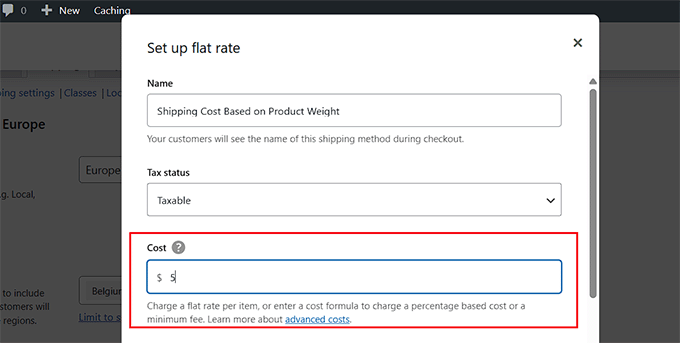

Subsequent, scroll all the way down to the ‘Delivery class prices’ part. Right here, you possibly can set a value for every weight-based transport class you’ve created.
For instance, you may cost $10 for objects within the 11–15 kg class and $20 for these within the 16–20 kg class.
⚠️ Essential Be aware: WooCommerce provides the transport class value on prime of the default flat price. For instance, in case your default value is $5 and the category value is $10, then the entire transport payment for the client might be $15.
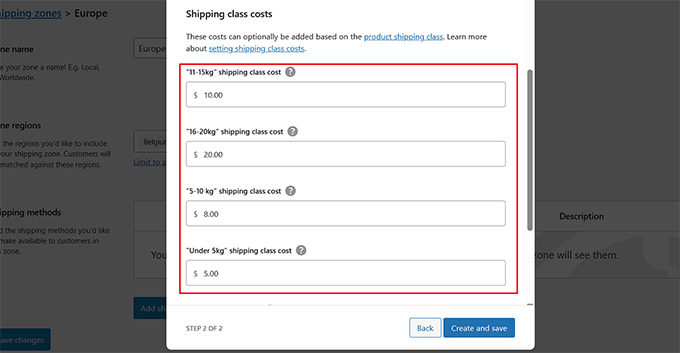

To keep away from this and use solely the transport class value, it’s essential to set the principle ‘Price’ discipline for the flat price to $0.
Just under the price fields, you’ll additionally see a setting referred to as ‘Calculation sort’. This controls how WooCommerce calculates transport when a cart accommodates objects from a number of courses.
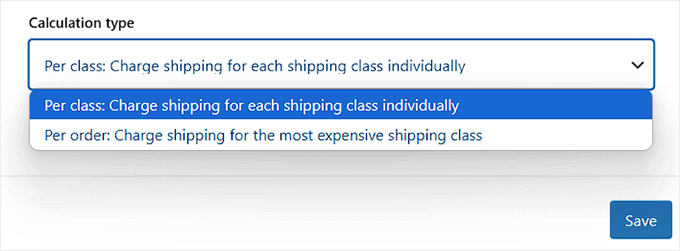

Right here is how every choice works:
- Per Class: WooCommerce will add the price for every particular person transport class within the order. For instance, if a buyer has an merchandise from the 11–15 kg class ($10 payment) and one other from the 16–20 kg class ($20 payment), then the entire added transport value might be $30.
- Per Order: WooCommerce will solely apply the price from the most costly transport class within the order. Utilizing the identical instance, solely the $20 payment can be added to the transport price.
For many shops that use weight-based transport, the ‘Per class’ choice provides you extra correct and truthful pricing. That is particularly useful when orders usually embrace merchandise of various weights.
Upon getting chosen your ‘Calculation Sort’, click on the ‘Save’ button to retailer your settings.
Now, head over to the ‘Merchandise’ web page and open your most well-liked merchandise within the WooCommerce editor. Scroll all the way down to the ‘Product Knowledge’ part and change to the ‘Delivery’ tab.
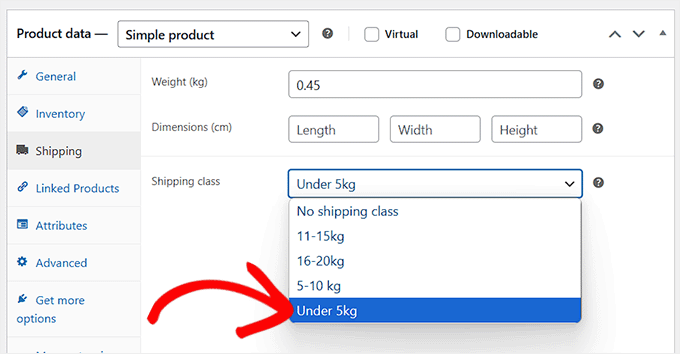

First, it’s worthwhile to enter the product’s weight within the ‘Weight’ discipline. After that, you’ll want to pick the right transport class from the ‘Delivery class’ dropdown menu.
💡 Professional Tip: Don’t neglect to incorporate the burden of your packaging supplies (like bins and bubble wrap) within the product’s whole weight. This helps you cost correct transport charges and keep away from shedding cash on postage.
For instance, in case your product weighs 0.45 kg, you would choose the ‘Underneath 5kg’ class you created earlier.
After that, click on the ‘Replace’ or ‘Publish’ button to avoid wasting your modifications.
Now go to your WooCommerce retailer to see the transport worth primarily based in your product’s weight.
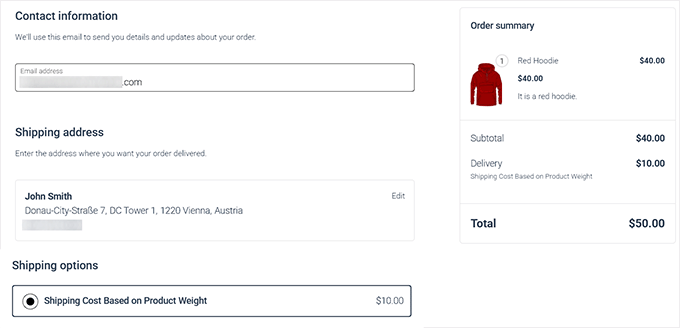

Whereas this technique works properly for easy setups, managing many alternative weight courses can turn into sophisticated.
So, if in case you have many merchandise or want extra versatile transport guidelines, then utilizing a devoted plugin is a a lot simpler resolution.
Methodology 2: Add Weight Primarily based Delivery Utilizing a Add-on (Really useful)
For extra highly effective and versatile transport guidelines, utilizing a devoted plugin is your best choice.
I like to recommend the free WooCommerce Weight Primarily based Delivery plugin as a result of it permits you to create as many transport guidelines as you need primarily based on product weight. You can even set completely different charges for various international locations and supply free transport when a buyer’s order reaches a sure whole.
First, it’s worthwhile to set up and activate the WooCommerce Weight Primarily based Delivery plugin. For particulars, see our tutorial on find out how to set up a CMS plugin.
Upon activation, head over to the WooCommerce » Settings » Delivery » Weight Primarily based Delivery web page from the CMS admin sidebar.
Right here, click on the ‘Set Up World Delivery Guidelines’ button.
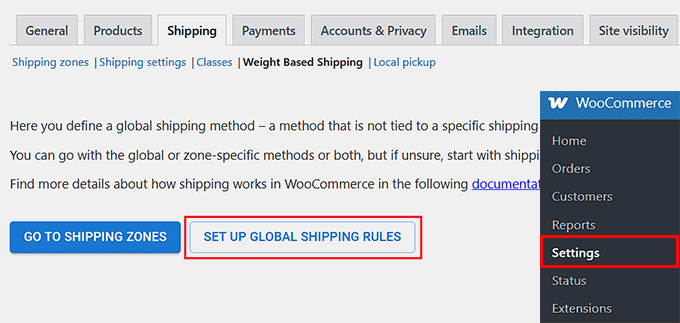

This can take you to a brand new display screen the place you possibly can outline weight-based transport guidelines in your merchandise. You’ll discover that the plugin comes with a couple of default guidelines already arrange, however you possibly can simply edit or delete them as wanted.
You can begin by including a title for every rule. Select names that show you how to shortly determine the burden vary, equivalent to ‘Underneath 5kg’ or ‘5-10kg’.
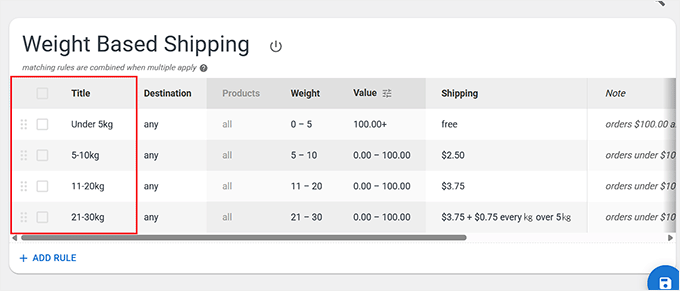

Within the ‘Vacation spot’ column, you possibly can depart the setting as ‘Any’. This implies the burden transport rule will apply to all international locations you ship to.
Nonetheless, if you wish to cost completely different transport charges for particular areas, you are able to do that by choosing a rustic from the ‘Vacation spot’ dropdown menu. This lets you apply your weight-based transport rule solely to that location.
For instance, let’s say your retailer relies in Europe. You may wish to cost $5 for orders beneath 5kg going to France as a result of it’s comparatively shut, and transport is cheaper.
However for a similar weight vary being shipped to the USA, you would cost $10 or extra to cowl the upper transport value because of the longer distance.
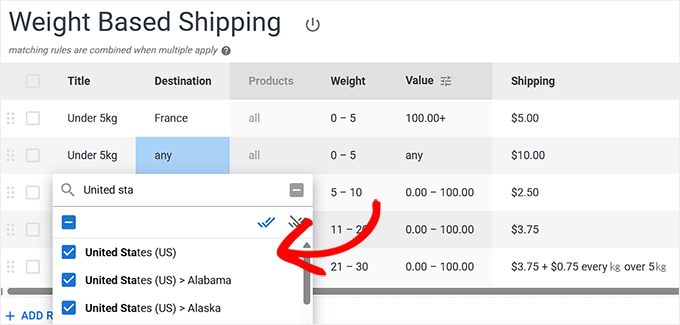

After that, set the ‘From’ and ‘Up To’ weight values for every rule within the Weight column. For instance, for the ‘Underneath 5kg’ rule, you possibly can enter From: 0 and Up To: 5.
When you’ve entered the numbers, click on the ‘OK’ button to avoid wasting the vary.
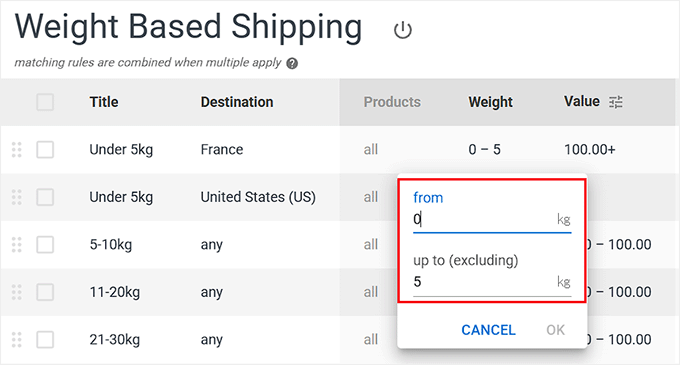

Subsequent, check out the ‘Worth’ column. That is the place you outline when the transport rule applies, often primarily based on the entire order quantity.
Let’s say you wish to supply free transport for small packages beneath 5kg, however provided that the client spends $100 or extra. In that case, you possibly can set the burden vary from 0 to five, and within the ‘Worth’ column, enter 100.00+. Then, set the transport value to ‘Free.’
This implies if somebody orders merchandise weighing beneath 5kg and their cart whole is $100 or extra, they gained’t need to pay something for transport.
Now, you may also wish to add one other rule for patrons who order lower than $100 price of things.
For that, create the identical weight vary—0 to 5kg—however within the ‘Worth’ column, enter 0.00 – 99.99 and set the transport value to one thing like $10.
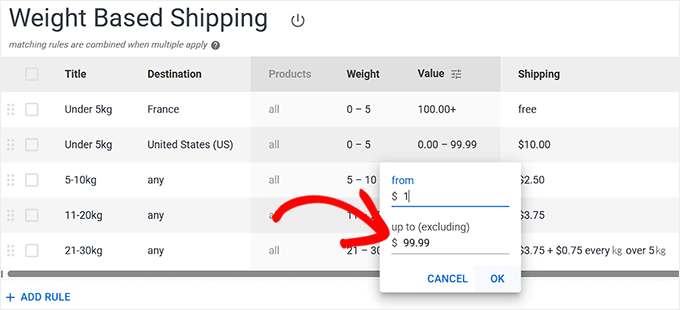

This implies if the cart is beneath 5kg and the order whole is under $100, then they’ll be charged $10 for transport.
💡 Professional Tip: If you need the transport rule to be primarily based solely on weight and ignore the cart’s whole worth, there’s a simple solution to do it.
Within the ‘Worth’ column, merely enter 0.00 within the ‘From’ discipline and depart the ‘To’ discipline utterly clean.
This tells the plugin to use the rule to all orders, irrespective of how a lot they value.
Now, it’s time to truly set the transport value primarily based on weight. For this, develop the ‘Delivery’ tab for every rule. You’ll be able to choose the ‘Free’ choice to supply free transport.
Or, select the ‘Flat’ choice and add the transport worth primarily based on weight.
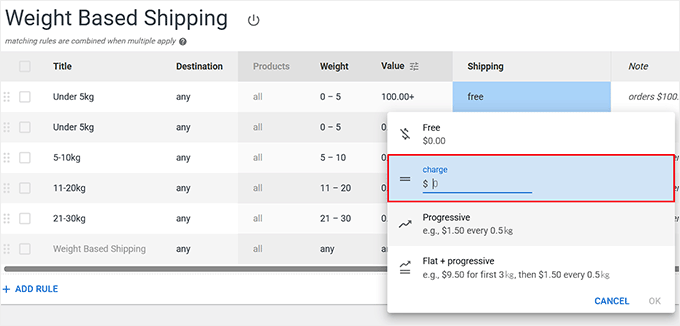

You can even select the ‘Flat + Progressive’ choice, which is useful for those who promote heavier objects that transcend your outlined weight guidelines.
For instance, let’s say your guidelines go as much as 30 kg. You’ll be able to set a Flat price of $20 for orders as much as 30 kg. Then, within the Progressive discipline, you possibly can add a value of $2 per 1 kg.
Now, if a buyer locations an order that weighs 32 kg, they’ll be charged the preliminary $20 (for the primary 30 kg) plus $4 (for the additional 2 kg), for a complete transport value of $24.
This setup ensures you’re nonetheless protecting your transport prices pretty, even for heavier orders.
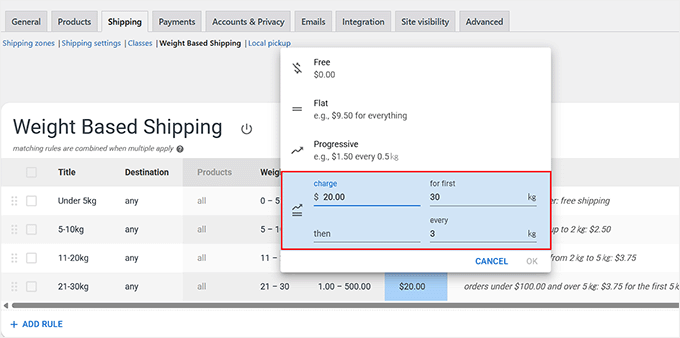

Subsequent, add a notice for every weight rule. This notice is only for you and your staff, and it helps maintain issues organized by explaining what every rule is for.
For instance, you possibly can write one thing like “Free transport for small orders over $100” or “Additional fees for objects over 30kg.”
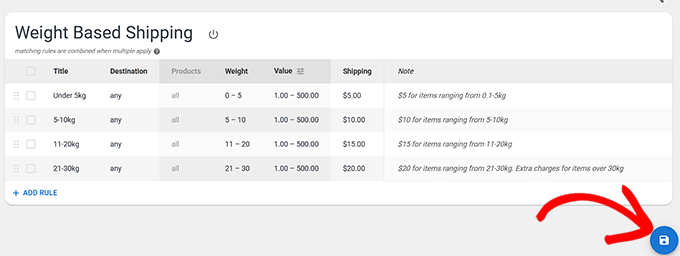

When you’ve added the notes, click on the ‘Save’ icon to retailer your settings.
Subsequent, it’s worthwhile to add the transport technique you created to one among your transport zones.
From the ‘Delivery’ tab, click on on a zone the place you wish to supply weight-based transport. Then, click on the ‘Add transport technique’ button.


This can open a popup on the display screen, the place it’s a must to select ‘Weight Primarily based Delivery’ because the transport technique.
Subsequent, click on the ‘Proceed’ button.
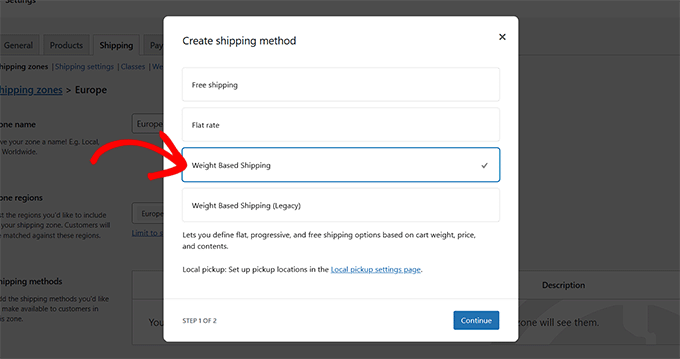

Then, head to the ‘Merchandise’ web page and open an merchandise within the editor.
From right here, scroll all the way down to the ‘Product Knowledge’ part and change to the ‘Delivery’ tab. Now, it’s a must to add the burden for the product to use the transport guidelines to it.


After that, merely click on the ‘Replace’ or ‘Publish’ button to retailer your settings.
Now, you possibly can go to your WooCommerce retailer and add a product to your cart.
You need to be capable of see the supply fees primarily based on the merchandise’ weight on the display screen.
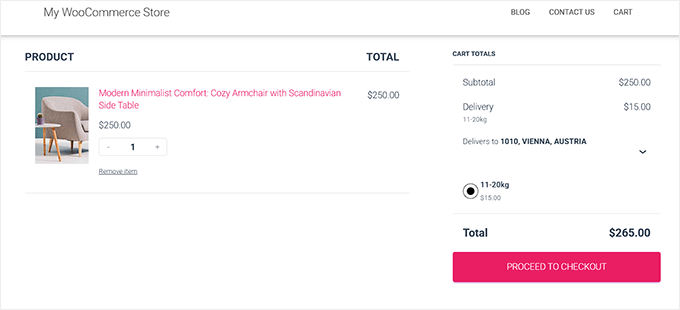

🎁 Bonus: Provide a Delivery Low cost in WooCommerce
Providing weight-based transport is nice for ensuring that your prospects are paying a good worth. However for those who’re additionally trying to enhance your gross sales, then I like to recommend offering transport reductions.
Many shoppers anticipate some form of deal relating to transport, particularly for bigger orders. Even a small low cost could make a distinction in conversions and buyer satisfaction.
That’s why providing a transport low cost is a good way to scale back cart abandonment and enhance your common order worth.
To simply add transport reductions to your WooCommerce retailer, I like to recommend utilizing the Superior Coupons plugin.


It’s beginner-friendly and offers you the facility to simply create transport low cost guidelines.
For instance, you possibly can supply free transport when a buyer’s cart reaches a sure whole, apply percentage-based reductions on transport prices, or mechanically set off particular transport offers primarily based on particular cart circumstances.
Plus, you possibly can mix these provides together with your weight-based transport guidelines for max flexibility.


To get began, see our tutorial on find out how to supply a transport low cost in WooCommerce.
FAQs: Weight Primarily based Delivery in WooCommerce
Listed here are the solutions to some frequent questions we get about organising weight-based transport in WooCommerce.
Do I’ve so as to add a weight to each single WooCommerce product?
Sure, for weight-based transport to work accurately, it’s essential to enter a weight for every bodily product in your retailer.
If a product doesn’t have a weight assigned, WooCommerce gained’t be capable of calculate the transport value for it precisely, and it might fall again to a default flat price or present no transport choices in any respect.
What occurs if a buyer has each bodily and digital merchandise of their cart?
WooCommerce mechanically handles this. Delivery prices will solely be calculated primarily based on the burden of the bodily objects within the cart. Digital merchandise, since they don’t require transport, don’t have any weight and won’t have an effect on the transport calculation.
Can I supply free transport for sure WooCommerce orders?
Completely. With the default technique, you possibly can create a transport class for a particular weight vary and set its value to $0.
With the plugin technique, you possibly can create a rule that gives free transport when an order reaches a sure weight or cart worth, supplying you with extra flexibility.
My merchandise have a really big selection of weights. What’s one of the best ways to deal with this?
The most effective method is to create a number of transport guidelines to cowl all of your merchandise. For very heavy objects that may exceed your heaviest rule, the plugin technique is right.
You should use its ‘Flat + Progressive’ choice to set a base price plus an additional cost per kg/lb, guaranteeing you at all times cowl your prices for outsized orders.
I hope this text helped you learn to simply add weight primarily based transport in WooCommerce. You may additionally wish to see our newbie’s information on find out how to add a free transport bar in WooCommerce and our tutorial on find out how to forestall fraud and faux orders in WooCommerce.
Should you favored this text, then please subscribe to our YouTube Channel for CMS video tutorials. You can even discover us on Twitter and Fb.

